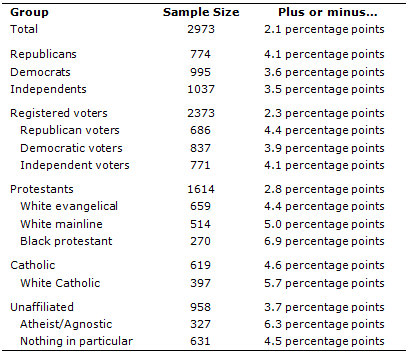The analysis in this report is based on telephone interviews conducted June 28-July 9, 2012, among a national sample of 2,973 adults, 18 years of age or older, living in all 50 U.S. states and the District of Columbia (1,771 respondents were interviewed on a landline telephone, and 1,202 were interviewed on a cell phone, including 596 who had no landline telephone). The survey was conducted by interviewers at Princeton Data Source and Universal Survey Center under the direction of Princeton Survey Research Associates International. A combination of landline and cell phone random digit dial samples were used; both samples were provided by Survey Sampling International. Interviews were conducted in English and Spanish. Respondents in the landline sample were selected by randomly asking for the youngest adult male or female who is now at home. Interviews in the cell sample were conducted with the person who answered the phone, if that person was an adult 18 years of age or older. For detailed information about our survey methodology, see http://pewresearch.org/pewresearch-org/politics/methodology/
The combined landline and cell phone sample are weighted using an iterative technique that matches gender, age, education, race, Hispanic origin and nativity and region to parameters from the March 2011 Census Bureau’s Current Population Survey and population density to parameters from the Decennial Census. The sample also is weighted to match current patterns of telephone status and relative usage of landline and cell phones (for those with both), based on extrapolations from the 2011 National Health Interview Survey. The weighting procedure also accounts for the fact that respondents with both landline and cell phones have a greater probability of being included in the combined sample and adjusts for household size among respondents with a landline phone.
An additional 511 interviews were conducted June 28-July 10, 2012, with religiously unaffiliated adults by screening landline and cell phone RDD samples (261 interviews) and by recontacting respondents from recent surveys who had identified as religiously unaffiliated (250 interviews). These interviews are used only when reporting on the religiously unaffiliated (including the unaffiliated subgroups – atheist, agnostic, and those who describe their religion as “nothing in particular”). For the RDD and cell phone recontact samples, respondents were initially selected in the same way as described above. For the landline recontact sample, interviewers asked to speak with the person based on gender and age who participated in the earlier survey. Once the selected respondents were on the phone, interviewers asked them a few questions and then asked their religious affiliation; those who are religiously unaffiliated continued with the remainder of the interview.
The weighting procedure for the additional interviews with religiously unaffiliated respondents used an iterative technique that included all of the parameters described above. In addition, the weighting accounted for the oversampling of unaffiliated respondents in the screened and callback samples, the type of unaffiliated respondent (atheist, agnostic or “nothing in particular”), as well as gender, age, region and the 2012 presidential vote preference among the unaffiliated. The parameters for the type of unaffiliated respondent and for gender, age and region among the unaffiliated are based on combined data from Pew Research Center surveys conducted from July 2011-June 2012. The parameter for the 2012 vote preference is based on the vote preferences of unaffiliated respondents in the main sample.
Sampling errors and statistical tests of significance take into account the effect of weighting. The following table shows the sample sizes and the error attributable to sampling that would be expected at the 95% level of confidence for different groups in the survey:
Sample sizes and sampling errors for other subgroups are available upon request.
In addition to sampling error, one should bear in mind that question wording and practical difficulties in conducting surveys can introduce error or bias into the findings of opinion polls.
